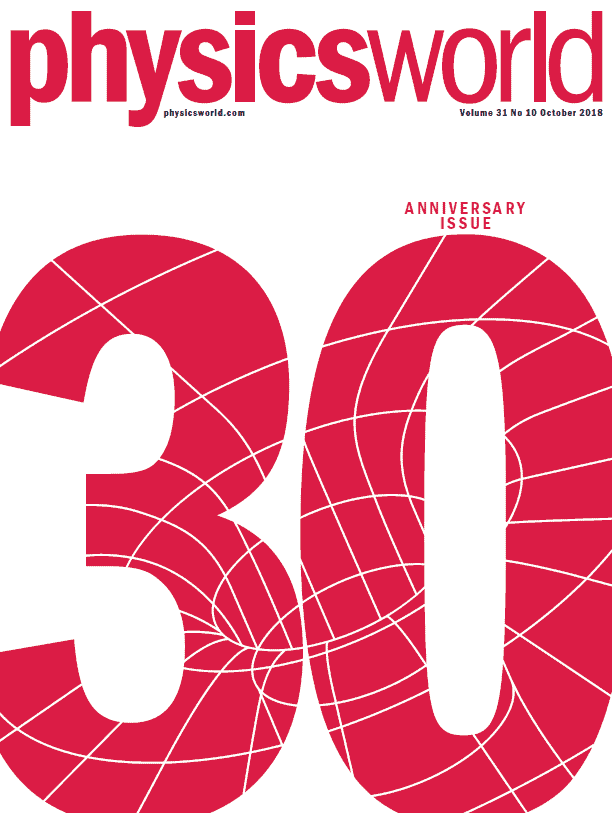
Whether you were around in 1988 or not, it’s time to sit back and see just how much physics has changed over the last three decades with the 30th-anniversary issue of Physics World magazine, which is now out in print and via our digital apps for iOS, Android and Web browsers.
When the Institute of Physics (IOP) launched Physics World in October of that year, the Cold War was still on, the Web didn’t exist and Stephen Hawking had just written A Brief History of Time. High-temperature superconductors were all the rage and some people even wanted to build a huge underground particle collider in Texas.
The special issue of Physics World – our biggest ever – revisits some of the key topics and issues in physics from 30 years ago, examines how they’ve developed, and contemplates their prospects over the next three decades.
Research into gravitational waves, which was just gearing up in 1988, has since opened an entirely new window on the cosmos. Particle physics has blossomed, even if the Standard Model remains intact. Optics and laser technology has revolutionized daily life. Practical fusion energy, however, still appears to be 30 years away, and as for high-temperature superconductivity, it fizzled and then revived.
You can also enjoy an interview with current IOP president Julia Higgins on the changing face of physics, discover the fate of the physics-based firms that advertised in the first issue of Physics World, and find out what some top authors and physicists think are the best popular-science books of the last 30 years. Scientific publishing and the role of member societies are covered too.
The 112-page issue also has our pick of your best letters, while theoretical physicist and comic artist Clifford Johnson draws a special Lateral Thoughts illustration of physics past, present and future.
Remember that if you’re a member of the Institute of Physics, you can read the whole of Physics World magazine every month via our digital apps for iOS, Android and Web browsers. Let us know what you think about the issue on Twitter, Facebook or by e-mailing us at pwld@iop.org.
For the record, here’s a run-down of what’s in the issue.
• The future for learned societies – Paul Hardaker explains why learned societies like the Institute of Physics must stay relevant to the modern world
• The online revolution – Steven Hall revisits the huge changes in journals publishing over the past 30 years
• The changing face of physics – Julia Higgins, president of the Institute of Physics, talks to Physics World managing editor Matin Durrani
about her career and how life for physicists has changed since the magazine was founded 30 years ago
• A solid (state) success – James McKenzie reflects on the impact of the solid-state laser, a device in its infancy when it became the subject of one of the first articles in Physics World
• Do you philosophize? – Physicists grapple with the challenges of philosophy far more often than you might think, as Robert P Crease reveals
• Back to the future – From financial woes and teacher shortages to major projects being delayed or cancelled, many issues facing physicists 30 years ago remain just as pertinent now as they did then. Michael Banks investigates
• Triumphs and frustrations – Particle physics has flourished over the past 30 years but, as Christine Sutton points out, there are still few signs of any cracks in the Standard Model
• Temperature’s rising – After three decades of slow-but-steady progress, the field of high-temperature superconductivity is generating excitement once again. Jon Cartwright explains
• Ignition pending – Reproducing the energy of stars here on Earth could revolutionize how we fuel our lives. But why does fusion energy always seem to be 30 years away? Melanie Windridge investigates
• A shining example – Since Physics World started, optics-based technologies have revolutionized the way we communicate. Jeff Hecht looks at how these methods have spread since their days in the lab
• It’s an ad, ad, ad, ad world – Margaret Harris looks back at some of the companies that advertised in the first issue of Physics World – and finds out how the industrial physics community has (and has not) changed
• A wave of discovery – James Hough outlines the last 30 years of gravitational-wave astronomy, from building prototype detectors to making a revolutionary discovery
• The physicists’ library – To compile the ultimate science reading list, Tushna Commissariat talks to some of today’s top physicists, writers and broadcasters
• Medical physics: a broad spectrum of careers – From clinical roles to jobs in industry and academia; from computational simulations to testing new scanners, Jude Dineley delves into the many job options available for medical physicists around the world today
• Snapshots through time – Physics, physicists and Physics World have transformed over the past 30 years, and will continue to do so. In this specially commissioned illustration, Clifford V Johnson takes us to the past, present and future of a physics lab.



